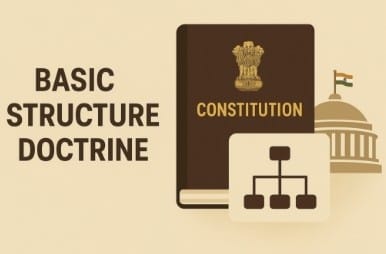
“The Constitution is not a mere lawyers’ document, it is a vehicle of life.” – Dr. B.R. Ambedkar
When we discuss Fundamental Rights, the common question asked is:
Who really does the protection besides Indian Judiciary- Article 13 or the Basic Structure Doctrine?
The truth is that India has a two-pronged protective system in its Constitution:
- Article 13 serves as one protection, voiding ordinary legal laws which run contrary to Fundamental Rights.
- The Basic Structure Doctrine formed from the case Kesavananda Bharati (1973), serves as the second protection on behalf of all citizenry in India restricting Parliament from obliterating the Constitution’s core.
As the Supreme Court observed, “The basic structure is the foundation on which the Constitution stands.”
Article 13 and the Basic Structure Doctrine represent twin protections that protect civility and Rights. Hence, none of our Laws, Amendments or Governments can efface the soul of the Constitution.
ARTICLE 13 of the Indian Constitution
Article 13 of the Indian Constitution gives primacy to Fundamental Rights in the constitutional framework by acting as a direct safeguard against legislative overreach. It ensures that ordinary laws must always respect the Constitution.
- All pre-constitutional laws inconsistent with the FRs should be void to the extent of inconsistency.
- All post-constitutional laws that violate FRs should be void to the extent of inconsistency.
- The law for Article 13 was to be interpreted in the landmark Shankari Prasad case.
- The Petitioner wants to uphold FR and takes the suggestions from DPSP. The Apex court showed regard for FR as precedence over DPSP but settled that the law in article 13 is meant to represent ordinary laws only.
Meaning of “Law” in Article 13
In simple terms, “law” is not just what Parliament passes. It includes any rule or authority that has legal force in India, such as:
- Ordinances (temporary laws by the President/Governor)
- Orders (directions issued by authority)
- Bye-laws (local body rules, e.g., municipal rules)
- Rules & Regulations (made by governments, boards, agencies)
- Notifications (official announcements with legal effect)
- Customs & Usages (traditional practices accepted as law in some communities
So, even non-Parliamentary rules can be struck down if they violate Fund
Meaning of “Laws in Force” in Article 13
This means laws made before the Constitution came into effect (1950), by colonial or princely legislatures, which:
- Were still valid at the time the Constitution started.
- Even if they were not applied everywhere or had become inactive in some areas, they still count as “laws in force.”
Example: Some British-era laws like the Indian Penal Code, 1860 or Indian Evidence Act, 1872 continue as “laws in force.”
Limitations of Article 13
- Originally limited constitutional amendments → Article 13 only concerned “law” (ordinary law, rules, regulations), but not constitutional amendments.
- Shankari Prasad (1951) → SC stated that Parliament could amend Fundamental Rights, “law” in Article 13 didn’t cover constitutional amendments.
- Sajjan Singh (1965) → affirmed Shankari Prasad; scope of Parliament’s power to amend FRs was still unlimited. That was simply a passing remark (obiter dictum).
- In the Golaknath Case 1967, the Supreme Court reversed the earlier judgment and held that “law” in Article 13 is to include both normal law as well as amendments to the Constitution.
- Loophole created → if Parliament desired, it could amend away or dilute Fundamental Rights through constitutional amendments.
Golaknath Case (1967) – A Watershed Moment
The petitioners challenged the constitutional amendments that curtailed their property rights. The Supreme Court (SC) said by a narrow margin of 6:5, the SC held:
- Constitutional amendments are also “law” as per
Article 13.
2. Parliament cannot amend or abridge
Fundamental Rights.
Impact:
- The SC now placed FRs above the amending power of Parliament.
- Directly contradicted Article 368, which gives the Parliament the power to amend the Constitution.
- Created a constitutional deadlock → Parliament v. Judiciary.
- Set the stage for Kesavananda Bharati case (1973), where the Basic Structure Doctrine was finally made.
Kesavananda Bharati Case (1973) – Dawn of the Second Shield
Kesavananda Bharati was a head of a Kerala math and he questioned Kerala Land Reforms Act 1963 statutes that limited property rights . This escalated to whether Parliament has unfettered powers to amend the Constitution. A Historic 13 Judge Bench which is the largest ever in Indian judicial history gave a narrow judgment of 7–6.
The Parliament, through the 24th CAA 1971 amended Article 13, adding 13 (4) which stated that – other provisions of Article 13 would not limit the amendment of the Constitution under Article 368.
The 24th CAA was challenged in the Supreme Court in the Kesavananda Bharati vs the State of Kerela case 1973.
Conviction-
Parliament can amend any part of the Constitution, including Fundamental Rights.
Parliament can’t alter or destroy the “Basic Structure” of the Constitution.
Importance:
- Enunciated the Basic Structure Doctrine – now a permanent judicial tool of safeguarding the Constitution.
- Enunciated that certain principles (like supremacy of Constitution, rule of law, separation of powers, secularism, judicial review, and Fundamental Rights) together comprise the identity of the Constitution.
- All Fundamental Rights are part of the Basic Structure and therefore altogether not susceptible to Parliamentary dis-charge.
Quote from the Judgment:
“Parliament is not supreme. It cannot change the basic structure or framework of the Constitution.” – Kesavananda Bharati case (1973)
The Basic Structure Doctrine:
- The Supreme Court upheld the Constitutionality of an act which was the 24th Constitutional Amendment Act (CAA).
- The term “law” in Article 13 means ordinary law, but did not mean CAAs.
- The power of the Parliament to modify the Constitution, therefore must include the power to amend FRs, as long as the basic structure of the Constitution is not diluted.
- The Basic Structure Doctrine is purely a judicial innovation, and is not a part of the Constitution, per se.
- The doctrine is organic and has developed through many pronouncements.
- The Parliament through the 42nd CAA wished to overturn the Kesavananda Bharati case judgment, through the insertion of a provision into Article 368.
- The 42nd CAA inserted Clauses 4 and 5 in Article 368 to give unlimited powers to the Parliament so as to amend the Constitution and also exempt such amendments to judicial review.
- Clauses 4 and 5 inserted by the 42nd CAA were declared unconstitutional by the apex court in Minerva Mills case.
Basic structure features as per different landmark cases:
- As per the Kesavananda Bharati Case:
i. Supremacy of the Constitution.
ii. Separation of the powers.
iii. Sovereignty and supremacy of India.
iv. Parliamentary form of government. - As per Minerva Mills Case:
i. Judicial review.
ii. Harmonious balance between the FRs and DPSPs. - As per the Bhim Singhji Case:
i. Welfare state promoting socio-economic justice. - As per SP Sampath Kumar’s Case:
i. Rule of law. - As per SR Bommai Case:
i. Secularism.
ii. Federalism. - As per M Nagaraja Case:
i. Principle of equality. - As per Kihoto Hollohan Case:
i. Free and fair election.
Interdependency – The Twin Shields
Article 13: The First Shield – This article is the first shield and strikes down ordinary laws made by Parliament or State legislatures if they violate Fundamental Rights.
Basic Structure Doctrine: The Second Shield – The basic structure doctrine arose as the second shield in 1973 in Kesavananda Bharati and guarantees laws passed to amend the Constitution, cannot be used to destroy its identity.
Two Tier Defence
Together, Article 13 and the basic structure doctrine, provide citizens with a conspiracy of two-tier defence of Fundamental Rights it provides two protections for Fundamental Rights:
- Ordinary laws checked by Article 13.
- Amendments to the Constitution checked by the basic structure doctrine.
Judicial Creativity
The Supreme Court’s creativity filled the gap that Article 13 intentionally left, which was the exclusion of constitutional amendments from its ambit. By developing the basic structure doctrine through jurisprudence, the judiciary ensured that while Parliament possesses power, it is not unguided power.
In peephole language “Article 13 is like the gatekeeper and the basic structure doctrine is the moat wall. Together they ensure protection of your Fundamental Rights is secured.”
Landmark Cases Linking Both
- Golaknath (1967) – First large battle – Article 13 vs Parliament’s power to amend. The Court ruled that Fundamental Rights cannot be amended.
- Kesavananda Bharati (1973) – The historic 13-judge bench described the balance of power as Parliament could amend the Constitution, however, it could not damage the Basic Structure.
- Minerva Mills (1980) – Reaffirmed the limits of power that amending power is itself subjected to Basic Structure.
These three cases show how Article 13 and basic structure doctrine have evolved in unison in shaping India and its context.
Critiques & Significance
Critiques
- Seen as judicial activism: unelected judges constraining elected Parliament.
- Parliament stated there should be a supreme mandate from the people.
It is free from Constitutional references. - It is a doctrine which is ambiguous and which is open to various interpretations and thus, advocates in favour of judicial supremacy.
- Judicial review also agitates judicial supremacy by which the judiciary may become a third legislative chamber.
- Basic structure doctrine in straightforward terms is a jurisprudential doctrine that attempts to limit the constituent power of the Parliament to amend the Constitution so as to up-hold the Constitutional supremacy.
Defenses
- Provides a kind of ‘safety valve‘: it stops majoritarian governments from taking away Fundamental Rights or democracy itself.
- Maintains a balance between parliamentary sovereignty (the will of the Parliament) and constitutional supremacy (the will of the Constitution).
- Preserves the souls of the Constitution and especially the liberal character of the Indian state, it upholds the FRs which are part of the basic structure.
- It enhances the separation of powers and the doctrine to ensure balance between the judiciary and the legislative.
Conclusion
Article 13 and the Basic Structure Doctrine are twin shields of Fundamental Rights.Article 13 renders ordinary legislation invalid which infringes rights.
The Basic Structure Doctrine prevents Parliament from successfully enacting constitutional amendments that undermine the Constitution’s values.
Both of these provisions guarantee Constitutional supremacy over temporary political majorities, protecting democracy and citizens’ freedoms for generations.
Want to master more such Constitutional concepts? Explore more on our blog now!


Informative 👏